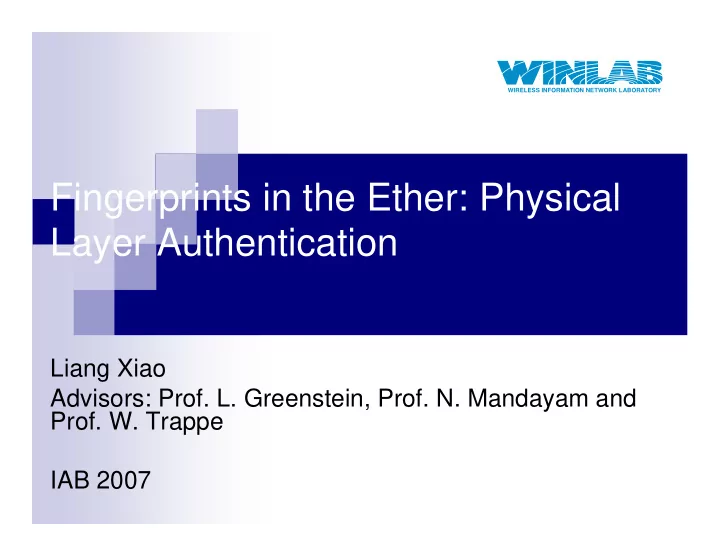

WIRELESS INFORMATION NETWORK LABORATORY Fingerprints in the Ether: Physical Layer Authentication Liang Xiao Advisors: Prof. L. Greenstein, Prof. N. Mandayam and Prof. W. Trappe IAB 2007
WIRELESS INFORMATION NETWORK LABORATORY Outline � Motivation & Main Idea � System Model & Hypothesis Test � Simulation & Results � Time-Invariant Channel with Receiver Thermal Noise � Time-Variant Channel with Background Changes � Conclusion & Future Work 2 5/21/2007
Motivation Wireless networks more “exposed” to security problems: •Spoofing attacks •Passive eavesdropping •DoS attacks •And more… 3 5/21/2007
Security Protocols Q1: Can we use the physical layer information to enhance security? A1: Yes, as we will see Q2: What is the value added? A2: My graduation depends on finding out … 4 5/21/2007
Main Idea: Fingerprints in the Ether � “Fingerprints” : Distinguishes channel responses of different paths to enhance authentication � Other examples that benefit from multipath fading: � CDMA : Rake processing that transforms multipath into a diversity- enhancing benefit � MIMO : Transforms scatter-induced Rayleigh fading into a capacity- enhancing benefit 5 5/21/2007
Fingerprints in the Ether (Cont.) The channel frequency response in the indoor environments � Frequency selective with spatial variability � Rapidly decorrelates with distance: hard to predict and to spoof Top View of Alcatel-Lucent’s Crawford Hill Laboratory, Holmdel, NJ 6 5/21/2007
PHY-Authentication Scenario TIME: 0 Bob estimates channel response H AB from Alice at time 0 Bob H AB u(t) • Narrow Pulse Alice t Probe Signal u(.) • Pilot Tones 7 5/21/2007
PHY-Authentication Scenario (Cont.) TIME: t Case 1: Alice is still transmitting. Bob estimates H t at time t, Bob and compares with H AB H t = H AB Eve Alice Probe Signal Desired result: Bob accepts the transmission. 8 5/21/2007
PHY-Authentication Scenario (Cont.) Case 2: Eve is transmitting, pretending to be Alice. TIME: t Bob estimates H t at time t, and Bob compares with H AB H t = H EB Probe Signal Alice Eve Desired result: Bob rejects the transmission. 9 5/21/2007
PHY-Authentication Via Hypothesis Test � Sample frequency response at M frequencies � Two complex frequency response vectors � � � � = T [ (0, ), (0, ),..., (0, )] H H f H f H f 1 2 AB AB AB AB M � � � � = T [ ( , ), ( , ),..., ( , )] H H t f H t f H t f t ? 1 ? 2 ? M � Simple Hypothesis: = H 0 : H H t AB ≠ H 1 : H H � � 1 t AB = − H e θ 2 j min || || Z H � Test Statistic: σ 2 A t θ � Phase measurement error due to changes of receiver local oscillator � Channel measurement assumed to be noisy 10 5/21/2007
Hypothesis Test (Cont.) Z > Γ � Rejection region of H 0 : � Detection Metrics α = > Γ � False Alarm Rate, 0 ( ) P Z H β = ≤ Γ � Miss Rate, 1 ( ) P Z H Γ � Threshold is chosen to satisfy > Γ = α 0 ( ) P Z H 11 5/21/2007
Simulation � Use ray-tracing tool WiSE (Wireless System Engineering) to generate channel responses for specified real environments � Eve in the same room as Alice � 348*347/2=60,378 Alice-Eve pairs 12 5/21/2007
Case 1: Time-Invariant Channel α = β 0.01 Average miss rate , for required false alarm rate α = 1 Sample Size (M) =5 Bandwidth (W) = 100 MHz Room # 1 13 5/21/2007
Case 2: Time-Variant Channel = + ε ( , ) ( ) ( , ) � Channel response H t f H f t f AB AB AB ε ( , ) � Tap-delay model for the inverse Fourier transform of AB t f � Single-sided exponential model as power delay profile � AR-1 Model for the time correlation � W=10 MHz, M=10 Time variation is negligible Time variation helps Time variation is so big that it hurts Thermal noise is negligible More time variation 14 5/21/2007
Conclusion & Future Work � We proposed a PHY-layer authentication scheme � Channel frequency response measurement and hypothesis testing are used to discriminate between a legitimate user and a would-be intruder � Verified using a ray-tracing tool (WiSE) for indoor environment � Works well, requiring reasonable values of the measurement bandwidth (e.g., W > 10 MHz), number of response samples (e.g., M ≤ 5) and transmit power (e.g., P T ~ 100 mW) � Channel time-variations can improve the performance � Ongoing work: � Cross-layer framework for security: protocol design � Terminal mobility � Measurements 15 5/21/2007
Thank you! Questions? 16 5/21/2007
References [1] L. Xiao, L. Greenstein, N. Mandayam, W. Trappe, “Fingerprints in the either: using the physical layer for wireless authentication,” IEEE ICC’ 2007, to appear. [2] L. Xiao, L. Greenstein, N. Mandayam, W. Trappe, “ Using the physical layer for wireless authentication in time-invariant channels,” submitted to IEEE Trans. On Wireless Communications , 2007. 17 5/21/2007
Recommend
More recommend